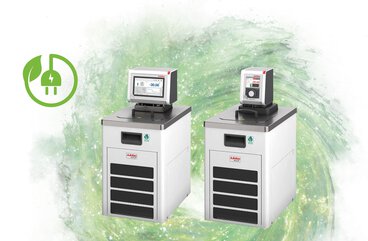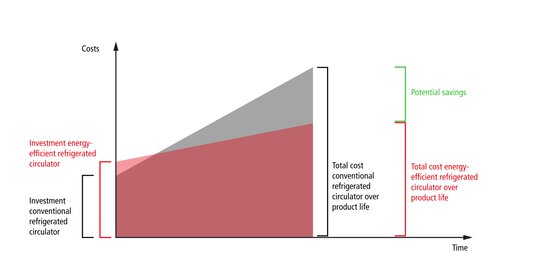Energy-Efficient Refrigerated Circulators
Protecting the environment and lowering operating costs
09/08/2023
Refrigerated circulators ensure reliable, accurate temperature control for applications involving samples, test specimens, and processes in, e.g., basic research, material testing, or technical systems. In many of these applications, partial load operation is usually sufficient for efficient heat withdrawal. Energy-efficient refrigerated circulators can help users save on operating costs while also reducing their environmental impact.
When investing in new laboratory equipment, it is important to carefully verify the expected operating conditions for the desired systems so that the corresponding potential energy savings can be taken into account.
What does energy efficiency mean?
Generally speaking, energy-efficient products are used when attempting to achieve a specified target with the lowest possible energy use – in our case, precise temperature control of an application. The less energy needed, the more energy-efficient a product is. Products on the market with a similar function and performance can be used as a reference.
When can it be helpful to make use of energy-efficient systems?
With virtually all temperature control systems, a distinction can be made between the socalled base load and the usage-dependent energy consumption. The base load is required to operate the system. Usage-dependent consumption, on the other hand, results from the specific application and is affected by various factors, such as the required cooling capacity, ambient conditions, or type and number of connected consumers. The proportion of usagedependent consumption is decisive for achieving greater energy efficiency.
To estimate the potential savings, the specific planned purpose of the systems must be considered. For many typical applications in the laboratory or industry, a fixed setpoint value is specified at the beginning of the temperature control process. The temperature control instrument then tries to reach this setpoint in the shortest possible time. To do so, every component involved is operated under high load. Once the set point is reached, the desired temperature is usually just maintained. Here, it is sufficient for the components
involved, e.g., fans or compressors, to operate at partial load. In these use cases, energy savings of up to 70% are possible when using energy-efficient temperature control systems.
Conventional refrigerated circulators with a cooling capacity of less than 500 watt are generally designed as capillary tube systems. These systems require comparatively little energy due to their low absolute cooling capacity. Using more expensive components, like electronic expansion valves and speed-controlled fans or compressors, to realize energysaving potential would significantly raise the price of these systems. At the same time, the overall effect in terms of energy savings would be very manageable due to their low cooling capacity.
In the past, JULABO has often used electronic expansion valves for refrigerated circulators with a cooling capacity of 600 watt or more in order to realize energy savings, among other things. The latest generation of refrigerated circulators is also equipped with speed controlled compressor and fan to provide greater savings potential. With the 800F and 1200F, the new refrigerated circulators are thus the first systems in their power range on the market that make use of this energy-saving potential.
How much energy can be saved: an example calculation
For this example, we will compare the MAGIO MS-1200F with the MAGIO MS-1000F. The MAGIO MS-1000F has an electronic expansion valve. The MAGIO MS-1200F is also equipped with a speed-controlled fan and compressor.
Operating point A:
The refrigerated circulator is temperature-controlled to the bath temperature specified in the table. In addition, energy is required to operate the pump. There is no additional load on the cooling machine (lower partial load range), and the temperature simply has to be maintained.
The result: In the lower partial load range, the energy required by the MAGIO MS-1200F is approx. 600 watt less than the energy required by the MAGIO MS-1000F. The MAGIO circulator also has a lower proportion, since the 1200F further reduces the minimum cooling capacity and less heating capacity is required for temperature control.
| Bath temperature | 20°C | 0°C | -20°C |
| Energy required in watt | |||
| MAGIO MS-1000F | 927 | 878 | 861 |
| Proportion, MAGIO circulator | 435 | 375 | 375 |
| Proportion, 1000F cooling machine | 492 | 503 | 486 |
| MAGIO MS-1200F | 296 | 279 | 279 |
| Proportion, MAGIO circulator | 195 | 175 | 175 |
| Proportion, 1200F cooling machine | 101 | 104 | 104 |
Operating point B:
The refrigerated circulator cools from +20°C to -20°C. There is an additional load requirement that ensures that the cooling machine cools at 100% power. The circulator does not require additional energy for temperature control. The only energy needed is for the pump.
The result: Even if the cooling machine of the inverter system cools permanently at 100% power, the required energy can be reduced by 150 watts compared to the pure expansion valve system.
| Bath temperature | 20°C ….-20°C |
| Energy required in watt | |
| MAGIO MS-1000F | 950 |
| Proportion, MAGIO circulator | 75 |
| Proportion, 1000F cooling machine | 875 |
| MAGIO MS-1200F | 800 |
| Proportion, MAGIO circulator | 75 |
| Proportion, 1200F cooling machine | 725 |
Amortization time
With refrigerated circulators of 800 watt or more, the energy savings result in rapid amortization of the initial additional costs. The cost saving results from the energy savings and the individual electricity price.
For our example calculation, we will again compare the MAGIO MS-1200F with the MAGIO MS-1000F. In this example, we assume that the application involves different temperature ramps and load requirements, and that the partial load range levels out at approx. 50%. Based on the above example, the resulting energy savings would amount to 400 watt per hour. Since refrigerated circulators are used worldwide, various electricity prices are shown. The period of use is very individual. As such, we have provided several example calculations.
| Example 1 | Example 2 | Example 3 | Example 4 | Example 5 | Example 6 | |
| Typical energy savings | 400 W | |||||
| Individual electricity price | €0,10 / kWh | €0,20 / kWh | €0,30 /kWh | |||
| Individual duration of use per day, 260 days per year | 7h | 24h | 7h | 24h | 7h | 24h |
| Cost savings per year | €73 | €250 | €146 | €499 | €218 | €749 |
The example calculation shows that energy-efficient technology can be used to realize significant energy savings and reduce operating costs. Even with low electricity costs, these systems have an amortization time of less than 2 years in many use cases. At the same time, the lower energy consumption means a positive contribution to climate protection.
Conclusion
Energy-efficient temperature control technology is perfect for many applications, especially with a cooling capacity of more than 800 watt. The higher associated procurement costs are normally amortized within less than 2 years due to lower electricity costs. At the same time, users help to protect environment by using energy-efficient refrigerated circulators.



